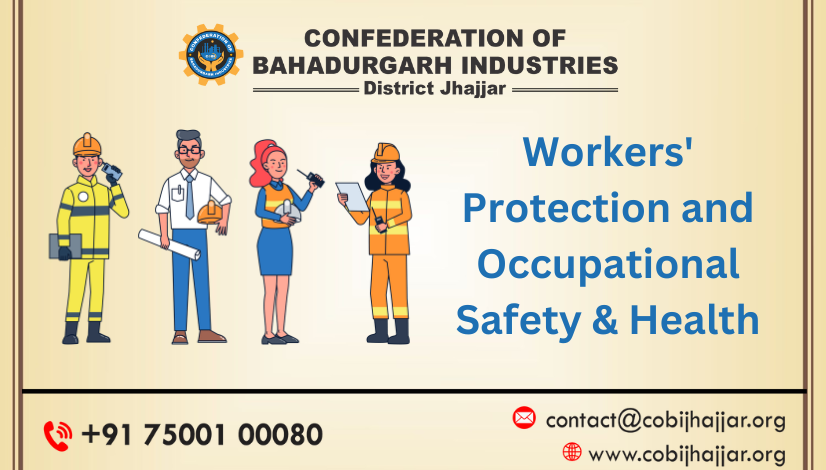Workers’ Protection and Occupational Safety & Health: Safeguarding the Workforce for a Sustainable Future
Workers’ Protection and Occupational Safety & Health – Ensuring a Safe Work Environment
In today’s fast-paced world, where industries continue to grow, ensuring the well-being of workers has become more critical than ever. Workers’ protection and occupational safety & health (OSH) are integral aspects of fostering a safe and sustainable work environment. This article delves into the significance of safeguarding the workforce and the essential role of OSH in creating a harmonious workplace conducive to growth and progress.
1. Importance of Workers’ Protection
Workers’ protection revolves around implementing measures to safeguard the rights, physical well-being, and mental health of employees. Prioritizing workers’ protection not only enhances their morale and productivity but also contributes to the overall growth of an organization.
A safe and protected workforce is more likely to remain loyal to the company, reducing employee turnover and associated costs. Moreover, workers who feel valued and secure are motivated to perform at their best, leading to increased efficiency and profitability.
2. The Role of Occupational Safety & Health (OSH)
Occupational Safety & Health (OSH) focuses on preventing work-related accidents, injuries, and illnesses. It involves identifying potential hazards in the workplace and implementing proactive measures to mitigate risks. An effective OSH program ensures compliance with safety regulations, minimizes workplace incidents, and promotes a culture of safety.
By investing in OSH, employers demonstrate their commitment to employee welfare, which, in turn, fosters a positive work environment and encourages employee loyalty. Safe and healthy workers are more engaged, resulting in improved productivity and higher job satisfaction levels.
3. Reducing Workplace Accidents and Injuries
Accidents and injuries in the workplace can have severe consequences for both employees and employers. These incidents often lead to financial losses, decreased productivity, and a negative impact on the company’s reputation.
Through OSH initiatives, organizations can significantly reduce workplace accidents and injuries. By providing necessary safety training, using proper equipment, and regularly inspecting work areas, potential hazards can be minimized, creating a safer environment for all employees.
4. Enhancing Employee Well-being
Workers’ protection and OSH initiatives extend beyond physical safety. They also encompass mental and emotional well-being. High-stress levels, long working hours, and job insecurity can lead to burnout and other mental health issues among employees.
Employers should prioritize employee well-being by promoting a healthy work-life balance, offering support services, and encouraging open communication. Happy and mentally healthy employees are more likely to be committed to their work and contribute to the organization’s success.
5. Legal and Ethical Responsibilities
Ensuring workers’ protection and OSH is not just a legal requirement but also an ethical responsibility for employers. Governments and regulatory bodies have established guidelines and standards to protect workers’ rights and welfare.
Compliance with these regulations is essential to avoid legal repercussions and maintain a positive public image. Organizations that genuinely prioritize workers’ protection build a reputation as socially responsible entities, attracting both customers and top talent.
6. Contributing to a Sustainable Future
A sustainable future relies on a harmonious relationship between businesses, employees, and the environment. Workers’ protection and OSH form a crucial part of this equation. A workforce that feels safe and valued fosters loyalty, reduces turnover, and encourages long-term commitment.
Moreover, minimizing workplace accidents and illnesses leads to reduced healthcare costs and increased productivity, positively impacting the overall economy. By prioritizing workers’ protection and OSH, organizations play a pivotal role in building a sustainable and prosperous future for all stakeholders.
Workers’ protection and occupational safety & health are vital pillars of a successful and sustainable work environment. By investing in the well-being of their employees, organizations create a positive workplace culture that enhances productivity, reduces turnover, and fosters growth.
Furthermore, prioritizing workers’ protection is not only a legal requirement but also an ethical responsibility. By fulfilling this obligation, businesses can build a positive reputation as socially responsible entities, attracting customers, investors, and top talent.
Ultimately, a safe and protected workforce forms the foundation for a prosperous and sustainable future, benefiting both organizations and society as a whole. By embracing workers’ protection and OSH, businesses demonstrate their commitment to a brighter tomorrow.




